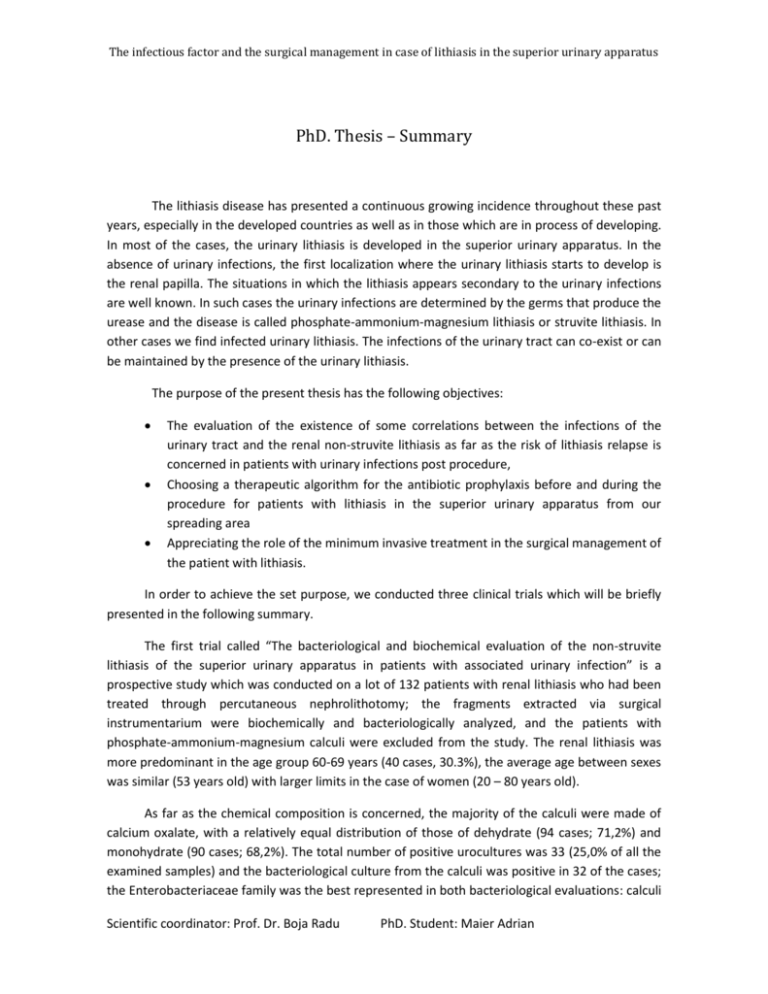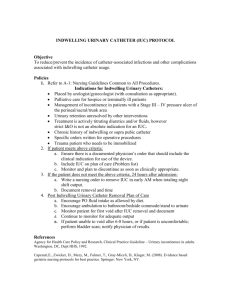The infectious factor and the surgical management in case of
advertisement

The infectious factor and the surgical management in case of lithiasis in the superior urinary apparatus PhD. Thesis – Summary The lithiasis disease has presented a continuous growing incidence throughout these past years, especially in the developed countries as well as in those which are in process of developing. In most of the cases, the urinary lithiasis is developed in the superior urinary apparatus. In the absence of urinary infections, the first localization where the urinary lithiasis starts to develop is the renal papilla. The situations in which the lithiasis appears secondary to the urinary infections are well known. In such cases the urinary infections are determined by the germs that produce the urease and the disease is called phosphate-ammonium-magnesium lithiasis or struvite lithiasis. In other cases we find infected urinary lithiasis. The infections of the urinary tract can co-exist or can be maintained by the presence of the urinary lithiasis. The purpose of the present thesis has the following objectives: The evaluation of the existence of some correlations between the infections of the urinary tract and the renal non-struvite lithiasis as far as the risk of lithiasis relapse is concerned in patients with urinary infections post procedure, Choosing a therapeutic algorithm for the antibiotic prophylaxis before and during the procedure for patients with lithiasis in the superior urinary apparatus from our spreading area Appreciating the role of the minimum invasive treatment in the surgical management of the patient with lithiasis. In order to achieve the set purpose, we conducted three clinical trials which will be briefly presented in the following summary. The first trial called “The bacteriological and biochemical evaluation of the non-struvite lithiasis of the superior urinary apparatus in patients with associated urinary infection” is a prospective study which was conducted on a lot of 132 patients with renal lithiasis who had been treated through percutaneous nephrolithotomy; the fragments extracted via surgical instrumentarium were biochemically and bacteriologically analyzed, and the patients with phosphate-ammonium-magnesium calculi were excluded from the study. The renal lithiasis was more predominant in the age group 60-69 years (40 cases, 30.3%), the average age between sexes was similar (53 years old) with larger limits in the case of women (20 – 80 years old). As far as the chemical composition is concerned, the majority of the calculi were made of calcium oxalate, with a relatively equal distribution of those of dehydrate (94 cases; 71,2%) and monohydrate (90 cases; 68,2%). The total number of positive urocultures was 33 (25,0% of all the examined samples) and the bacteriological culture from the calculi was positive in 32 of the cases; the Enterobacteriaceae family was the best represented in both bacteriological evaluations: calculi Scientific coordinator: Prof. Dr. Boja Radu PhD. Student: Maier Adrian The infectious factor and the surgical management in case of lithiasis in the superior urinary apparatus (20 cases; 62.5%) and uroculture (21 cases; 63.6%). In a small number of 7 cases (which represents 5,3% from the total of the samples) the uroculture was positive but without bacterial growth in the calculi exam; the indentified bacteria were Escherichia coli, Enterococcus spp., Pseudomonas aeruginosa, Staphylococcus aureus. However, in 5 of the cases (3,8% of the total of the samples) negative urocultures were found but with a positive bacteriological exam of the calculi: Pseudomonas aeruginosa (2 cases) and one each case of Candida albicans, Escherichia coli, Proteus mirabilis. The 93 left cases (70,4%) did not present any bacterial growth neither in the uroculture exam nor in the bacteriological exam of the calculi. Starting from the idea of an infected lithiasis we conducted the second trial called “The analysis of the spectrum and the susceptibility of the uropathogens from our spreading area and of the corresponding choice of the antibiotic therapy”. The main purpose of this study is to analyze the susceptibility of the uropathogens from our spreading area and to compare the results with the recommendations of the European Association Guidelines of Urology in order to reach the most efficient antibiotic treatment with the role of preventing the infectious and lithiasis relapse. We analyzed 474 positive urocultures from which we included in the study the positive urocultures for the negative Gram germs. The negative Gram Bacili most frequently isolated in the uroculture exam are represented by: Escherichia coli, followed by Klebsiella pneumonia, Pseudomonas aeruginosa, Enterobacter spp., Proteus mirabilis and other bacteriological stems with a smaller incidence: Citrobacter spp., Serattia marcescens, Acinetobacter, Morganella Morgagni. From the total of the urinary infections with negative Gram germs 86(18,14%) cases were positive for the ESBL germs. The ESBL stems were represented by: Escherichia coli, Klebsiella pneumonia, Proteus mirabilis, Pseudomonas aeruginosa și Enterobacter spp. The Escherichia coli’s sensibility to antibiotics was over 50% for the majority of the tested antibiotics: nalidixic acid, betalactamins, cephalosporins, nitrofurantoin, fluoroquinolones and aminoglycosides. Escherichia coli presented a resistance of 38% to trimethoprimsulfamethoxazole. An increased resistance was observed in the case of ampicillin (62%) and tetracycline (52%). Klebsiella pneumonia presents the highest sensibility to cephalosporins (ceftazidim, cefepim, ceftriaxon) and aminoglycosides (gentamicin) while we have an increased resistance of over 60% to nalidixic acid, fluoroquinolones, nitrofurantoin, trimethoprimsulfamethoxazole. The resistance to ampicillin is 100%. The analysis of the resistance to antibiotics for the two groups of bacterial stems (negative-Gram and negative-Gram ESBL) showed a statistically significant correlation (p˂0.0001) in the case: augmentin, nalidixic acid, fluoroquinolones, gentamicin and tobramicin. The modern treatment of the urinary apparatus lithiasis is based on minimally invasive methods and in order to appreciate the position of these therapies in the management of the urinary lithiasis we conducted the third trial called “The position of the minimum invasive treatment in the surgical management of the superior urinary apparatus lithiasis- indications, complications (infectious, obstructive) results.” Scientific coordinator: Prof. Dr. Boja Radu PhD. Student: Maier Adrian The infectious factor and the surgical management in case of lithiasis in the superior urinary apparatus We analyzed the post-operatory results in 1253 patients with renal lithiasis, reno-urethral and urethral which were treated with open surgery and minimum invasive surgery Extracorporeal shock wave lithotripsy (ESWL), percutaneous nephrolithotomy (NLP) and retrograde ureteroscopy (URSR). The distribution according to sex of the surgical interventions for the reno-urethral lithiasis showed a similar repartition for the open surgeries, but with a statistically significant association (p=0.008) in the case of NLP which was more frequent in women while ESWL and URSR were used more frequently for men. In general, we did not have major complications that would jeopardize patients’ lives. The complications that appeared in the case of the open surgeries were represented by: wound opening one case and wound suppuration 9 cases. The evolution in the case of the minimum invasive therapeutic procedures – ESWL was encumbered by the presence of the subcapsular hematomas 9 cases, of the acute pyelonephritis one case and of the steinstrasse with different localizations in 27 cases. Although a minimum invasive intervention, the retrograde ureteroscopy is not without complications; in the studied lot we revealed: acute pyelonephritis and septic state, infectious complications, most probably secondary to pre-existent urinary infections. In the case of percutaneous nephrolithotomy we revealed the following situations: retroperitoneal hematoma, hemorrhage in which case a re-intervention through open surgery was necessary for hemostasis, septic state. The efficiency of the treatment for the urinary apparatus lithiasis is represented by the “stone free” rate, the remnant fragments causing lithiasis relapse. The lot of patients treated with ESWL presents a rate of “stone free” of 83.53%, those with big calculi being more predisposed to remnant fragments in comparison to patients with smaller calculi (p-0.0001). We obtained an OR=4.00 (IC95%: 2.56-6.24). In the case of the retrograde ureteroscopy we had a stone free rate of 95.78%; we have a OR=6.25 (IC95%: 0.74-57.396), without any statistically significant correlation for the remnant fragments in comparison to the size of the calculi (p-0.09). Based on the three clinical trials we reached the following general conclusions: The superior urinary apparatus lithiasis with a different compostion from that of phosphate ammonium magnesium can also be determined by the presence of the negative Gram germs in urine. Escheria coli remains the most frequent germ present in the infections of the urinary tract from our spreading area. The urinary infections with negative Gram germs ESBL represent an important percentage from the total of the urinary tract infections; its therapeutic treatment needs associated therapies. The most frequently indicated minimum invasive treatment in the case of the superior urinary apparatus lithiasis remains the Extracorporeal shock wave lithotripsy (ESWL). The risk of developing urinary infections is higher in the case of the patients previously treated through NLP and URSR in comparison to those treated through ESWL. Although used in a small number of cases today, open surgery still remains a valid therapeutical option for the cases which are too complicated as to use the minimum invasive treatment or in the case of failure of the minimum invasive therapy. Scientific coordinator: Prof. Dr. Boja Radu PhD. Student: Maier Adrian The infectious factor and the surgical management in case of lithiasis in the superior urinary apparatus Scientific coordinator: Prof. Dr. Boja Radu PhD. Student: Maier Adrian








